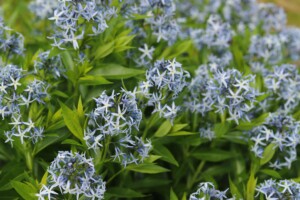Research conducted and descriptions written by Burley Middle School 6th grade students in 2023 with minor editing by RCA staff.
The eastern blue-star blooms in May and June. It blooms in open rocky woods and in bunches. The blue-star’s scientific name is Amsonia tabernaemontana. Blue dogbane is another common name for this plant. The blue-star likes to be in the sun or light shade, in wet sandy sites, in thin woods and on plains. It grows from 2-3 feet tall. The plants slowly increase in size over time, but are not an invasive species. The blue-star is a perennial plant native to parts of Virginia and more common in the Midwest. The blue-star represents determination, endurance, and strength. The blue-star grows for two to three years. The flowers attract various long-tongued insects, like carpenter bees and hummingbird moths. It is one of several host plants for the snowberry clearwing butterfly.
Fun fact: The foliage of blue-star contains a toxic white latex, making it very deer and herbivore resistant.

